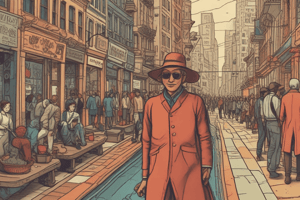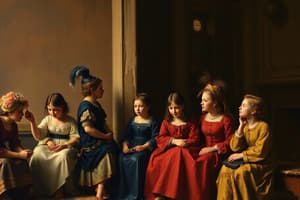Podcast
Questions and Answers
What is a key question in understanding class inequality?
What is a key question in understanding class inequality?
How did class inequality reproduce intergenerationally? Why do most people stay in the same social class into which they were born?
What does 'those who fail' refer to?
What does 'those who fail' refer to?
Using a 'quitter's copout' and not embracing the 'achievement ideology' or making an accurate assessment of, and a rational response to, their disadvantage.
Match the three levels of analysis of MacLeod:
Match the three levels of analysis of MacLeod:
Individual = Focuses on personal choices and attributes Structural = Examines societal institutions and systems Cultural = Looks at shared beliefs and values within a society
What describes the life world of Clarendon Heights?
What describes the life world of Clarendon Heights?
Signup and view all the answers
Who are the Brothers?
Who are the Brothers?
Signup and view all the answers
Who are the Hallway Hangers?
Who are the Hallway Hangers?
Signup and view all the answers
What is social reproduction theory concerned with?
What is social reproduction theory concerned with?
Signup and view all the answers
What principle is associated with social reproduction according to Gintis and Bowles?
What principle is associated with social reproduction according to Gintis and Bowles?
Signup and view all the answers
What do the concepts of 'cultural capital' and 'habitus' refer to?
What do the concepts of 'cultural capital' and 'habitus' refer to?
Signup and view all the answers
What does the relationship between structure and agency suggest?
What does the relationship between structure and agency suggest?
Signup and view all the answers
What are some differences between the families of the Hallway Hangers and the Brothers?
What are some differences between the families of the Hallway Hangers and the Brothers?
Signup and view all the answers
What is the difference between jobs and careers?
What is the difference between jobs and careers?
Signup and view all the answers
What challenges did the Hallway Hangers face upon returning to Clarendon Heights in 1991?
What challenges did the Hallway Hangers face upon returning to Clarendon Heights in 1991?
Signup and view all the answers
What happened to the Brothers eight years later?
What happened to the Brothers eight years later?
Signup and view all the answers
What does 'outclassed and outcast(e)' imply about class society?
What does 'outclassed and outcast(e)' imply about class society?
Signup and view all the answers
Study Notes
Key Question
- Examines how class inequality persists across generations.
- Explores why individuals predominantly remain in their birth social class.
Those Who Fail
- Represents individuals who reject "achievement ideology."
- Attributes failure to a lack of rational assessment of disadvantages, termed as "quitter's copout."
Three Levels of Analysis
- Identifies three frameworks for understanding social dynamics: individual, structural, and cultural.
Life World of Clarendon Heights
- Describes a deteriorating public housing project plagued by severe social issues: poverty, unemployment, substance abuse, crime, and racism.
The Brothers
- A predominantly Black group of optimistic young men.
- They abstain from drugs, avoid serious delinquency, and show commitment to education.
Hallway Hangers
- Mainly a white group characterized by pessimism regarding their future.
- Engage in drug abuse and delinquent behavior, showing a lack of effort in academic pursuits.
Social Reproduction Theory
- Investigates how social class is perpetuated across generations.
- Discusses "culture of poverty" as a personal explanation and "structure of poverty" as an explanation based on place and institutional practices.
Gintis and Bowles on Social Reproduction
- Introduces the Correspondence Principle linking educational settings to professional environments.
- Highlights similarities between teachers and bosses, as well as the control over knowledge and rewards.
Concepts of Social Reproduction
- Discusses "cultural capital," which encompasses nonmaterial resources like knowledge and social skills.
- Defines "habitus" as a framework shaping perceptions and interactions, influencing how individuals interpret the world.
Relationship Between Structure and Agency
- Describes a circular interaction where social class influences culture (habitus), which subsequently impacts personal beliefs, values, and behaviors.
- Questions why individuals from the same socioeconomic background can have vastly different aspirations.
Influence of the Family
- Analyzes distinctions between the family environments of the Hallway Hangers and the Brothers.
- Considers the impact of time spent in public housing and the role of race and policies like affirmative action on children's aspirations.
Work: Job Versus Career
- Differentiates between job expectations and career aspirations.
Return to Clarendon Heights in 1991
- Many Hallway Hangers are excluded from legitimate job markets, with some resorting to the drug trade or underground economies.
- Discusses the connection between personal failures and broader societal issues, referencing C. Wright Mills' concept of private troubles and public issues.
The Brothers: Eight Years Later
- Highlights the struggle of the Brothers despite their earlier aspirations and commitment, finding themselves trapped in low-wage jobs.
- Points to a lack of social capital and network connections as significant barriers.
"Outclassed and Outcast(e)"
- Explores the dynamics of structure versus agency, questioning the experiences of individuals like Super.
- Challenges the notion that individual choice transcends social class, correlating with DeMott's example of supposed choice to pursue a scientific career.
Studying That Suits You
Use AI to generate personalized quizzes and flashcards to suit your learning preferences.
Description
This quiz explores the persistence of class inequality and the factors contributing to individuals remaining in their birth social class. It examines the perspectives of different groups, such as the optimistic young men of 'The Brothers' and the pessimistic 'Hallway Hangers,' while also analyzing social issues prevalent in areas like Clarendon Heights.




